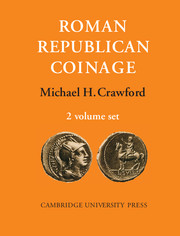Book contents
- Frontmatter
- Contents
- VOLUME I
- INTRODUCTION
- CATALOGUE
- VOLUME II
- misc-frontmatter
- 1 Technique and Technology
- 2 Weight Standards
- 3 Monetary Magistrates
- 4 Special Formulae
- 5 Administration and Control
- 6 Roman Units of Reckoning Under the Republic
- 7 Coinage and Finance
- 8 Careers of the Moneyers
- 9 Types and Legends
- 10 Art and Coinage
- Plates
- Indices
- Plate section
2 - Weight Standards
from VOLUME II
Published online by Cambridge University Press: 07 October 2011
- Frontmatter
- Contents
- VOLUME I
- INTRODUCTION
- CATALOGUE
- VOLUME II
- misc-frontmatter
- 1 Technique and Technology
- 2 Weight Standards
- 3 Monetary Magistrates
- 4 Special Formulae
- 5 Administration and Control
- 6 Roman Units of Reckoning Under the Republic
- 7 Coinage and Finance
- 8 Careers of the Moneyers
- 9 Types and Legends
- 10 Art and Coinage
- Plates
- Indices
- Plate section
Summary
Since the theoretical and actual weight standards of an issue of coinage may differ, our understanding of the financial history of the Roman Republic will clearly be affected not only by variations in theoretical weight standards, but also by the extent to which theoretical weight standards were observed. Some basic problems have to be faced. Although we possess a certain amount of literary information about Republican weight standards, the identification of the issues struck according to these theoretical standards depends on the discovery of the actual weight standards of the issues (one may even have to guess on the basis of these what the theoretical standards are). There are in addition notorious practical difficulties in the way of establishing actual weight standards and in the way of expressing the theoretical weight standards of Rome in modern terms.
THE ROMAN POUND
The weight standard of the earliest Roman silver coinage, the didrachm coinage, was borrowed from the silver coinage of Campania.l But the standard of the Roman didrachm coinage was rapidly adjusted downwards to a level which stands in a simple 3: 2 relationship with the level at which the standard of the denarius began its existence. This standard of the denarius in turn stands in a series of simple relationships with the various standards of the mainstream bronze coinage of the Roman Republic. These in turn can all be expressed in terms of the Roman pound, which may be regarded as being by the time of the early Republic a distinctively Roman unit of weight. Valuations in pounds of bronze constituted for the Romans the first step towards coinage, taken in the course of the fourth century, and the unit on which the earliest issue of bronze coinage was based weighed just a pound. This unit was called the as.
The ultimate origin of the Roman pound and the derivation of the word’ as’ are both obscure. But the existence of the words ‘dupondius’ or ‘doubleweight’ and ‘assipondium’ or ‘singleweight' should imply that as far as the coinage is concerned ‘as’ simply means’ unit'. The term was perhaps taken over together with its subdivisions into 12 ounces and 288 scruples from the terminology of length or area measurement.
- Type
- Chapter
- Information
- Roman Republican Coinage , pp. 590 - 597Publisher: Cambridge University PressPrint publication year: 1975



